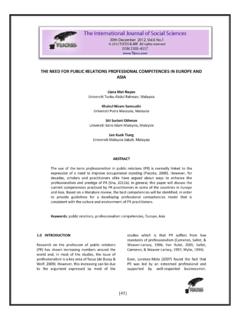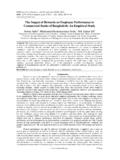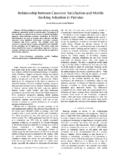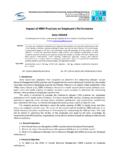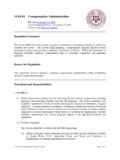Transcription of THE RELATIONSHIP BETWEEN DIRECTOR REMUNERATION …
1 THE RELATIONSHIP BETWEEN DIRECTOR REMUNERATION AND. performance OF FIRMS LISTED IN THE NAIROBI SECURITIES EXCHANGE. 1. Ben Miyienda, 2 Cliff Osoro Oirere, 3 Julius Miyogo 1. Ben Miyienda, Kisii University, Kisii, Kenya. 2. Cliff Osoro Oirere, Kisii University, Kisii, Kenya. 3. Julius Miyogo, Kisii University, Kisii, Kenya Email: , , 3 1. Abstract This study examined the RELATIONSHIP of Directors' REMUNERATION and company performance for 57. firms listed on the Nairobi Securities Exchange for a period from 2006 through 2010. The study demonstrates the existence of a positive link BETWEEN directors' REMUNERATION and ROE, EAT and Tobin's Q as measures of firm performance .
2 Further it concludes that among Kenyan listed companies, directors' REMUNERATION has a weak RELATIONSHIP with ROE and Tobin's Q, but a moderately strong positive RELATIONSHIP with EAT. The implication of this finding is that, among Kenyan listed companies, directors REMUNERATION is strongly linked to raw performance indicators as opposed to measures of efficiency of utilization of shareholder funds and market performance . These findings therefore point towards high possibility of agency problem since directors can benefit themselves by maximizing raw earnings without due regard to long term performance and market performance .
3 Keywords: Directors' REMUNERATION , firm performance , corporate governance INTRODUCTION Fried, 2003 emphasized that the Directors'. REMUNERATION , if not well structured, will actually Most large businesses today are run as companies contribute which are distinct legal entities from the owners (often referred to as shareholders). Bebchuk and The generalisability of much published research Fried, 2003 affirms that since it may not be possible based on the directors' REMUNERATION on the for all the shareholders to take part in the company's performance is problematic. A serious management process, they appoint directors to act on weakness with this argument, was pointed out by their behalf, giving rise to a principal-agent Rosen, 1992 who states that firm performance is RELATIONSHIP , subsequently an agency problem.
4 The influenced by several factors, arising from both agency problem arises when the directors benefit internal and external sources to the company). from the company at the expense of the shareholders However, Kaplan and Norton (1992) points out that by designing REMUNERATION packages where they businesses tends to lay emphasis on quantitative award themselves very high salaries and other performance measurement metrics, while factors like benefits that may reduce profits that are available for consumer satisfaction and innovation are also equally distribution to the shareholders (Jensen and important areas of analyzing firm performance .
5 Meckling, 1976). This happens because the directors Jensen and Meckling, 1976; Jensen and Murphy and are in a strategic position in the organization structure Kerin (2003) affirms that firms must have a balance to influence their pay (Bratton, 2005). Bebchuk and BETWEEN fixed and variable pay to executives as the 1. fixed pay ensures that directors get some pay whether Alternatively, Shleifer and Vishny (1997) states that or not the company performs well, since they will corporate governance deals with the assurance that have rendered services to the company. In addition to providers of finance to firms get of a return on their the agency problem, high Directors' REMUNERATION is investment.
6 Caramanollis-C telli (1995) also also due to greed by executives and weak governance explains that fair allocation among stakeholders by shareholders (AKST, 2006). within and outside the firm determines corporate governance. Stakeholders include shareholders, One of the more significant findings that emerge suppliers, creditors, employees, customers, and the from the studies reviewed so far is that there are general public. various possible ways through which directors'. REMUNERATION may influence firm performance . An John and Senbet (1998) argues that corporate implication of this is the possibility that this debate governance deals with mechanisms by which on Directors' REMUNERATION is unlikely to end.
7 Whilst stakeholders of a business protect their interests by this study does confirm the RELATIONSHIP BETWEEN the exercising control over the management. Better general structure of Directors' REMUNERATION and corporate governance practices are seen by many corporate performance ., it fails to substantiate countries as a way of enhancing overall economic evidence about the extent to which corporations are performance by improving economic dynamism. This prepared to publicly disclose details about their has resulted in many countries encouraging corporate executives' REMUNERATION contracts or packages and governance principles and even making them annual changes in the values of entitlements and mandatory through legislation, and enforcing payouts under these packages.
8 Compliance by regulators. Equitable treatment of all shareholders, enhanced disclosure requirements, LITERATURE REVIEW communication with the shareholders, and an effective board of directors, is some of the important Shareholders of joint stock companies need to principles of corporate governance (OECD, 1999). appoint directors to manage the companies on their The firm has to consider fair REMUNERATION for its behalf. This results to a principal-agent RELATIONSHIP directors that is based on firm performance , in order where the shareholders are referred to as the to discharge its duties effectively. principals while the directors are the agents.
9 On contrary, Jensen and Meckling (1976) argue that a Williamson (1966) suggests that managers would principal agent RELATIONSHIP also arises when the seek to maximize their own utility and consider the shareholders borrow and hence act as agents of the implications of this for firm behavior in contrast to lenders, this paper narrows the principal-agent the profit-maximizing case. He suggested that RELATIONSHIP to that BETWEEN shareholders and managers' interests are best served by maximizing directors. sales after achieving a minimum level of profit which satisfies shareholders. More recently this has Berle and Means (1932) presents the main factors developed into principal agent' analysis which that lead to the agency problem as the separation of models a widely applicable case where a principal (a ownership and control, and asymmetric information shareholder or firm for example) cannot costlessly BETWEEN shareholders and executives.
10 The infer how an agent (a manager or supplier, say) is information asymmetry enables managers to use their behaving. This may arise either because the agent has discretion to benefit their private interests in various greater expertise or knowledge than the principal, or ways. Jensen and Meckling (1976) argues that the because the principal cannot directly observe the agency problem has made it necessary for agent's actions; it is asymmetric information which shareholders to effectively monitor the directors, and leads to a problem of moral hazard. This means that thus incur agency costs. Perrow (1986) criticizes the to an extent managers can pursue their own interests.
